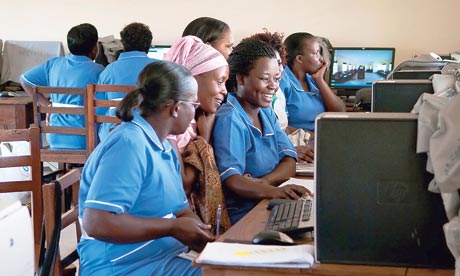Grace Aguti gives one final push. She leans back exhausted on the plastic mattress and listens for her baby's cry, but there is only silence. Her eyes flash with panic as she looks down and sees the umbilical cord wrapped tightly around her baby's neck, its tiny body slowly turning blue.
Using the last surgical gloves in stock, the midwife effortlessly clamps and cuts the cord to free the baby, rushing it to the examining table. After a few tense moments, high-pitched cries echo around the dimly lit labour room and a tearful Aguti lets out a cry of relief.
Giving birth in Uganda can be a matter of life and death. Luckily, 37-year-old Aguti was with a midwife who knew what to do when something went wrong. Many women and babies in Uganda are not so fortunate, and, for every 100,000 live births there, 430 mothers die.
The African Medical and Research Foundation (Amref) warns that without more sufficiently skilled midwives in Uganda, the fifth millennium development goal of reducing maternal mortality rates by 2015 will not be met. Only 38% of the 11,759 midwives in Uganda are fully registered and qualified to diploma level. Amref believes this should be 100%.
The midwife presents the healthy baby boy to his eagerly awaiting mother, who smiles contentedly. "I have a lot of pain but I am very happy," she says. "The baby I had before this one died in the village when he was born and I bled for many weeks, so this time I came to the midwife. When I knew the baby was coming I travelled here on the back of a bicycle. It took over an hour."
There is little privacy in the Tiriri health centre IV, in Soroti, eastern Uganda. Aguti shares the small ward with a dozen other women who lie on beds with no sheets or curtains, inches away from one another.
Midwife Esther Madudu scans the ward. "If the cord had wrapped around the baby in the village, or somewhere with a less-qualified midwife, the people assisting the birth would not have had the skills to unravel it. The baby most certainly would have died," she says.
But despite a lack of well-trained midwives in Uganda, many find it difficult to afford to take unpaid study leave and move away from their families for further training. This leaves thousands without the advanced skills required to deal with more complicated cases.
As a result, Amref is using e-learning to train more midwives to diploma level, the first time this has been done in Uganda. Midwives study in their spare time and put what they learn into practice at work. Critically, this means that they are not leaving a gap in healthcare services by temporarily vacating their jobs for training.
So far, the programme has attracted 73 midwives who would otherwise be unable to do further training. However, many of the students are struggling to get to grips with the computers they need to use to complete their studies, and unreliable electricity and internet connections are an issue.
"Computers are a new thing for me," says Amref student, Jackeline Kobusingye. "E-learning is a big challenge and access to a computer is a problem. Some are broken and sometimes there is no power."
Whether technological innovation can succeed without basic infrastructure, such as electricity, is up for debate. However, the challenges of infrastructure and technology should not get in the way of innovation, argues Nicholas Tembo, the district education officer for Arua, in north-west Uganda, one of the regions where the e-learning programme is being piloted.
Tembo says: "We cannot hide our heads in the sand. The globe is now a village where everything is online and this is the way we need to move. E-learning is a wonderful new method of studying in Uganda, making students responsible for their own education. Secondary schools here use solar power for computers. Surely they can share them with midwives? It is about forming partnerships. We are learning from the challenges and we can overcome them."
Transport problems
There are still many other basic obstacles to reducing maternal death rates in Uganda, for example, many women do not even have the means to travel to a health clinic should something go wrong during their pregnancy. However, Amref believes e-learning will at least play a vital role in improving the standard and number of midwives.
The charity's approach has already proved successful in other countries. Amref's e-learning project manager, Eva Musimenta, says: "In Kenya, we used e-learning to train more than 7,000 nurses in five years, so we know it is possible. Once we have piloted the programme and dealt with the challenges, we hope to roll out e-learning across other districts in Uganda, to train even more midwives across all skill levels and significantly reduce maternal mortality rates."
Back in the Tiriri health centre IV, another woman has started to deliver. She moans heavily on her bed as children play around her. Aguti will be taking little Peter home in a couple of hours. For now, though, she pulls her thin kanga (wrap) over their heads, so that, for a few moments, they can get to know each other in private. After losing her last baby, she smiles down contentedly as Peter sleeps. She can only imagine how different it could have been if she hadn't made it to the midwife in time.

